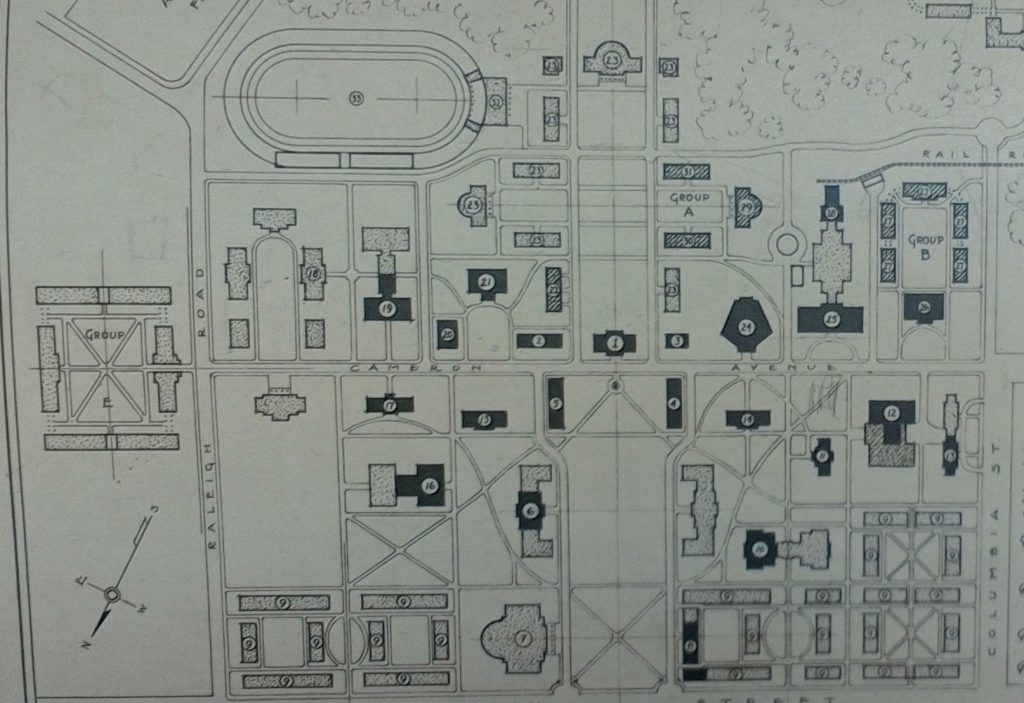By Shannon Brien
In 1921, the University’s Board of Trustees received $1.49 million in government funding to plan a massive campus expansion, with the intention of both diversifying the University’s academic capabilities and accommodating a larger number of students.1 Among the dozens of new buildings, the Trustees planned for five new dormitories in order to house three hundred and fifty students.2 The Trustees were not only accounting for an increased student population that the University was experiencing in the aftermath of World War I, but also attempting to provide students with an on-campus housing option that would keep the young men out of the boarding houses in downtown Chapel Hill and the vices associated with such quarters.3
Four of these dormitories were built along a quad to the east of present-day Manning Hall, which at the time served as the University’s law school.

A 1921 map for campus expansion, with existing buildings in solid black ink and proposed buildings in spotted grey. In a Report by Aberthaw Construction Company to the Board of Trustees.
On June 13, 1922, the Buildings Committee proposed Ruffin Dormitory as the new name for what had previously been referred to only as “Dormitory E.”4 This dormitory was named after Thomas Ruffin Sr. (1787-1870) and his son Thomas Ruffin Jr. (1824-1889), both of whom served as justices on the North Carolina Supreme Court during the 19th century. The elder Ruffin served on the Board of Trustees from 1813 to 1831 and again from 1842 to 1868, while the younger Ruffin’s only official connection to UNC came as an 1844 alumnus of the undergraduate program.
Below are two excerpts from the 1922 minutes of the Board of Trustees (June 13 and December 20 meetings):
Thomas Ruffin Sr. was born into the plantation elite of southeastern Virginia and studied in New Jersey and Virginia before entering the bar in 1808 in Hillsborough, NC.5 He represented Orange County in the House of Commons for three terms between 1813-1816, and then began his judicial career as a justice of the North Carolina Supreme Court.
He served as the Chief Justice from 1833-1852, with his most well known case being State v Mann. In this ruling, Ruffin declared that “the power of the master must be absolute to render the submission of the slave perfect.”6 In recent times this ruling has caused much controversy, with some declaring Ruffin a white supremacist while others argue that he was simply operating within the legal system of the time. Legal scholar Alfred Brophy, for instance, has argued that “Ruffin policed the boundary between cold legal logic and the warm sentiments of the heart, which might have yielded a more human result for the slaves.”7
The Board of Trustees did not discuss this specific ruling when deciding to name this building after Ruffin, and therefore it is difficult to know how their opinions on the case may have swayed their regard for the man.
Thomas Ruffin Jr. took after his father as a lawyer, passing the bar at the age of 21.8 He worked in Rockingham County in the decade before the Civil War, then put his career on hold to join the war effort. Ruffin was wounded in battle in September 1862, so he resigned from his post and instead served on the Confederate military court. After the war, Ruffin involved himself in law and politics in Orange County until his death in 1889.
In various official campus sources, Ruffin Dormitory is noted as being named after solely the elder Ruffin. The University’s virtual Names Across the Landscape site only references Ruffin Sr. in its exhibit on the Ruffin Residence Hall.9 As Thomas Ruffin Sr. has a larger reputation than his son, it is possible that this is a case of one personality simply overshadowing another. It is not clear at what point the University only began to recognize Ruffin Sr., and whether or not that was a conscious decision.
1Minutes of the Board of Trustees, June 14, 1921, The Board of Trustees of the University of North Carolina Records #40001, University Archives, Wilson Library, University of North Carolina at Chapel Hill.
2The Construction Program of the University of North Carolina: A report by Aberthaw Construction Company, 1921,The Board of Trustees of the University of North Carolina Records #40001, University Archives, Wilson Library, University of North Carolina at Chapel Hill.
3Ibid.
4Minutes of the Board of Trustees, June 13, 1922, The Board of Trustees of the University of North Carolina Records #40001, University Archives, Wilson Library, University of North Carolina at Chapel Hill.
5Blackwell Robinson, “Ruffin, Thomas,” NCPedia, 1 January 1994. Accessed 18 November, 2015.
6Ibid.
7Alfred L. Brophy. “Thomas Ruffin: Of Moral Philosophy and Monuments,” Presented at The Perils of Public Homage: State v. Mann and Thomas Ruffin in History and Memory, Chapel Hill, NC, 16 November 2007.
8Thomas W. Austin, “Ruffin, Thomas Jr.,” NCPedia, 1 January 1994. Accessed 19 November 2015.
9“Thomas Ruffin (1787-1870) and Ruffin Residence Hall,” The Carolina Story: A Virtual Museum of University History. Accessed 25 November 2015.
